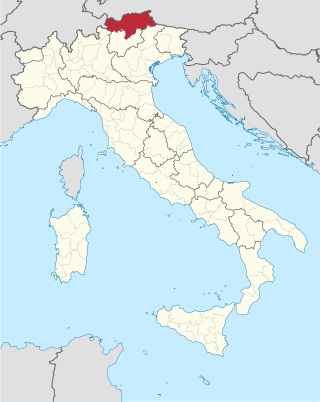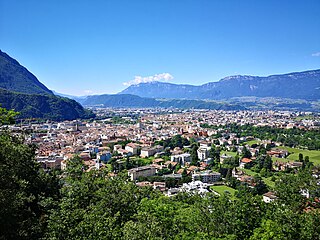
South Tyrol is an autonomous province in northern Italy. An English translation of the official German and Italian names could be the Autonomous Province of Bolzano – South Tyrol, reflecting the multilingualism and different naming conventions in the area. Together with Trentino, South Tyrol forms the autonomous region of Trentino-Alto Adige/Südtirol. The province is the northernmost of Italy, the second largest with an area of 7,400 square kilometres (2,857 sq mi), and has a total population of about 534,000 inhabitants as of 2021. Its capital and largest city is Bolzano.

Bolzano is the capital city of South Tyrol, Northern Italy. With a population of 108,245, Bolzano is also by far the largest city in South Tyrol and the third largest in historical Tyrol. The greater metro area has about 250000 inhabitants and is one of the urban centres within the Alps.

Trentino-Alto Adige/Südtirol is an autonomous region of Italy, located in the northern part of the country. The region has a population of 1.1 million, of whom 62% speak Italian as their mother tongue, 30% speak South Tyrolean German and several foreign languages are spoken by immigrant communities. Since the 1970s, most legislative and administrative powers have been transferred to the two self-governing provinces that make up the region: the province of Trento, commonly known as Trentino, and the province of Bolzano, commonly known as South Tyrol. In South Tyrol, German remains the sizeable majority language.

The Adige is the second-longest river in Italy, after the Po. It rises near the Reschen Pass in the Vinschgau in the province of South Tyrol, near the Italian border with Austria and Switzerland, and flows 410 kilometres (250 mi) through most of northeastern Italy to the Adriatic Sea.

Brixen is a town and commune in South Tyrol, northern Italy, located about 40 kilometres (25 mi) north of Bolzano.

The Wipp Valley is an Alpine valley in Tyrol, Austria and in South Tyrol, Italy, running between Innsbruck and Franzensfeste. The Brenner Pass at the Austro-Italian border divides it into the northern, Austrian Lower Wipp Valley and the southern, Italian Upper Wipp Valley. The Lower Wipp Valley extends along the Sill River southward from Innsbruck, where the Sill meets the larger Inn River, up to the Brenner Pass. South of the border, the Upper Wipp Valley stretches along the Eisack River by way of Sterzing to Franzensfeste. It forms the Wipptal District of the province of South Tyrol.

The Brenner Base Tunnel is a 55-kilometre-long (34 mi) railway tunnel under construction through the base of the Eastern Alps beneath the Brenner Pass. Once completed, the Brenner Base Tunnel will rank as either the second or third longest railway tunnel in the world, depending on the definition employed. It will be surpassed in length only by the Gotthard Base Tunnel in Switzerland and, depending on the relative completion dates of these projects, the Mont d'Ambin Base Tunnel between France and Italy. When combined with the Inntal Tunnel, which forms part of the existing Innsbruck bypass, the Brenner Base Tunnel will reach a length of 64 kilometres (40 mi), making it the longest underground railway connection in the world.

Brenner is a comune and a village in South Tyrol in northern Italy, located about 60 km (37 mi) north of Bolzano on the border with Tyrol, Austria.

The Brenner Autobahn refers to a major European truck route that connects Innsbruck in Austria to Verona in northern Italy.

Innsbruck Hauptbahnhof is the main railway station in Innsbruck, the capital city of the Austrian federal state of Tyrol. Opened in 1853, the station is a major hub for western and central Austria. In 2019, it was the 8th-busiest station in the country, and the 2nd-busiest outside of Vienna after only Linz Hauptbahnhof, with 315 train movements and 38,500 passengers daily.

Verona Porta Nuova is the main railway station of Verona, Italy. It is one of the two stations serving central Verona; the other station, Verona Porta Vescovo, is located at the east of the city.

The Brenner Railway is a major line connecting the Austrian and Italian railways from Innsbruck to Verona, climbing up the Wipptal, passing over the Brenner Pass, descending down the Eisacktal to Bolzano/Bozen, then further down the Adige Valley to Rovereto/Rofreit, and along the section of the Adige Valley, called in Italian the "Vallagarina", to Verona. This railway line is part of the Line 1 of Trans-European Transport Networks (TEN-T). It is considered a "fundamental" line by the state railways Ferrovie dello Stato (FS).

The Berlin–Palermo railway axis is project No. 1 of the Trans-European high-speed rail network (TEN-R), which involves the creation of a 2,200-kilometre-long (1,400 mi) high-speed rail line between Berlin and Palermo. It is designated as one of the main transport links connecting Central and Southern Europe, tracking through Germany, Austria and Italy.

Bolzano/Bozen railway station is the main station of Bolzano, capital of the autonomous province of South Tyrol, in northeastern Italy.

Trento railway station is the main station of Trento, capital of the autonomous province of Trentino, in northeastern Italy.

Rovereto railway station serves the Comune of Rovereto in the autonomous province of Trentino, northeastern Italy.

Brenner railway station is the border station of Italy and Austria. It serves the town and comune of Brenner in the autonomous province of South Tyrol, northeastern Italy.

Tyrol is a historical region in the Alps of Northern Italy and western Austria. The area was historically the core of the County of Tyrol, part of the Holy Roman Empire, Austrian Empire and Austria-Hungary, from its formation in the 12th century until 1919. In 1919, following World War I and the dissolution of Austria-Hungary, it was divided into two modern administrative parts through the Treaty of Saint-Germain-en-Laye:
The South Tyrolean Unterland or Bozen Unterland is a section of the Etschtal valley stretching from the regional capital Bolzano (Bozen) down the Adige (Etsch) river to Tramin and Salorno (Salurn). The area is known for its history, particularly regarding Rhaetic, Roman, and Germanic archaeological sites; its bilingualism, and its viticulture; the Gewürztraminer grape originated here.

The Autostrada A22 or Autobrennero or Autostrada del Brennero is one of the most important autostrada in Italy, as it connects Po Valley, the city of Modena and the Autostrada A1 to Austria through the Brenner Pass, located in the municipality of Brenner. The Autostrada A22 is 315 kilometres (196 mi) long. It is a part of the E45 European route. The operator of the road is Autostrada del Brennero S.p.A.. The Autostrada A22 is located in the regions of Emilia-Romagna, Lombardy, Veneto and Trentino-Alto Adige/Südtirol.























